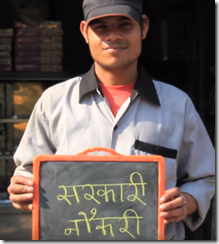In one of the largest such exercises ever conducted in the world, millions of applicants are appearing this month for an online recruitment test conducted by the Indian Railways.
The Railways Recruitment Board (RRB) has received more than 24 million applications for roughly 120,000 vacancies in the organization. Most recruitment drives by government departments across the country generate similar enthusiasm among job seekers and it is quite common to find thousands of applicants, including PhDs and postgraduates, for low-end government job vacancies.

Data from the successive rounds of nationally representative youth surveys conducted by the Lokniti research programme at the Centre for the Study of Developing Societies (CSDS) shows that the attraction of a sarkari naukri(government job) has not shown any signs of declining over the past decade. In fact, the share of youth who prefer a government job has grown slightly to 65% in 2016.
The share of youth who prefer a private job has nearly halved to 7% between the two rounds of the survey conducted in 2007 and 2016. The share of those wanting to start their own enterprises has risen marginally to 19% over the same period.
The 2007 and 2016 surveys covered 5,513 and 6,122 individuals, respectively. We compare the responses of individuals in the age group of 15-34 years.
Rural and urban youth hardly differ when it comes to job preferences. But the share of youth in big cities who prefer a government job shows a sharp increase between 2007 and 2016.
The rising preference for government jobs in big cities could be driven by a search for stability as well as the declining income differential between the private and public sector, especially in entry-level jobs.
Big cities here include the 10 most populous cities of India (Delhi, Mumbai, Kolkata, Chennai, Hyderabad, Bengaluru, Ahmedabad, Jaipur, Surat and Pune) spread across eight states and the most populous cities of 11 other states surveyed. Other cities have been classified as small cities in the analysis.
Among all groups, preference for government jobs is highest among the college-educated rural youth (82%). It is this segment that has also been at the forefront of recent agitations for extending reservation benefits to new groups. Urban youth who have studied beyond high school were relatively more likely to look beyond the public sector as compared with their rural counterparts.
Interestingly, there are no substantial differences in opinion based on economic class or social groups. For instance, 63% of respondents from poor households said they prefer government jobs while 65% from the upper middle class said so.
In the latest survey, respondents were also asked to choose between a permanent job with a relatively low salary, a job with like-minded co-workers, a well-earning job, or a job with high job satisfaction. A plurality of respondents (33%) chose job stability while high job satisfaction was the second most popular option. This explains why public sector employment remains so sought after among the youth. Almost half of the respondents who preferred governments also prioritized stability.
On the other hand, youngsters who preferred private sector jobs and self-employment mostly prioritized either job satisfaction or good income.
The sentiment on job creation has been the Achilles’ heel of the Narendra Modi government and it continues to remain tepid. In the successive rounds of the Mood of the Nation surveys conducted by Lokniti-CSDS over the past year, it has consistently emerged as one of the most important issues for the public.
Providing permanent government jobs is an even bigger challenge given that public employment has been shrinking in post-liberalization India.
The pre-liberalization wish of liberalization’s children will not be easy to fulfil.
